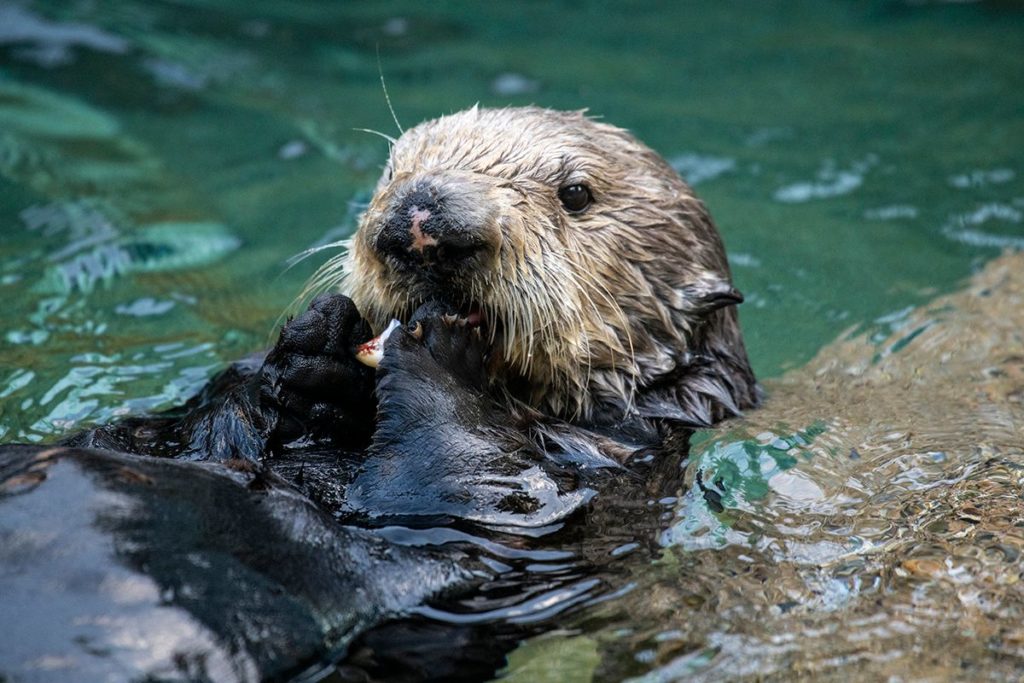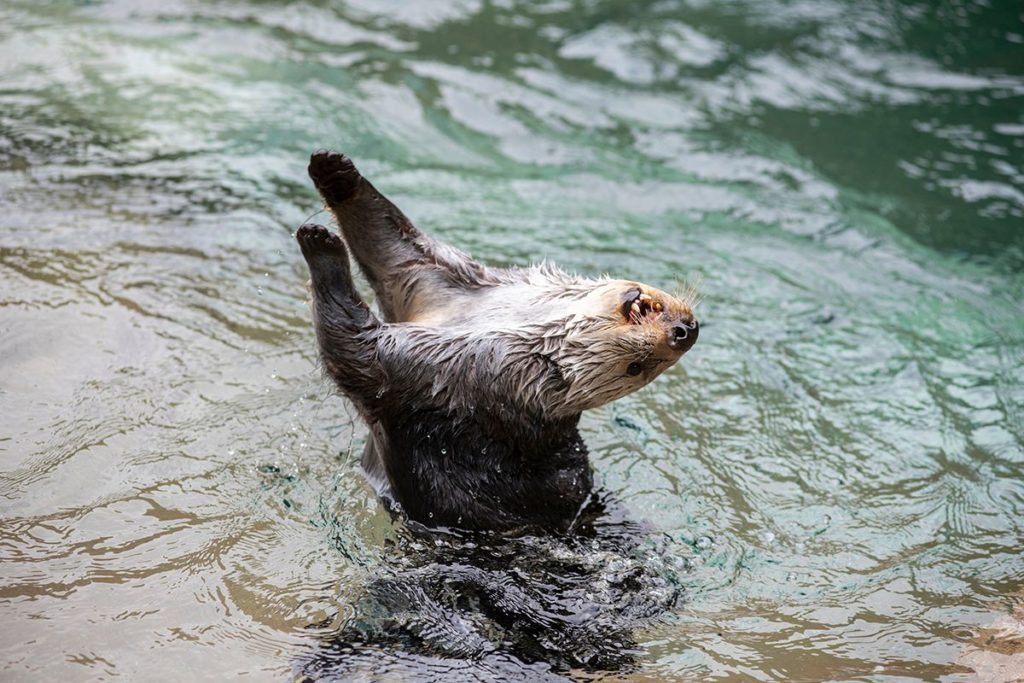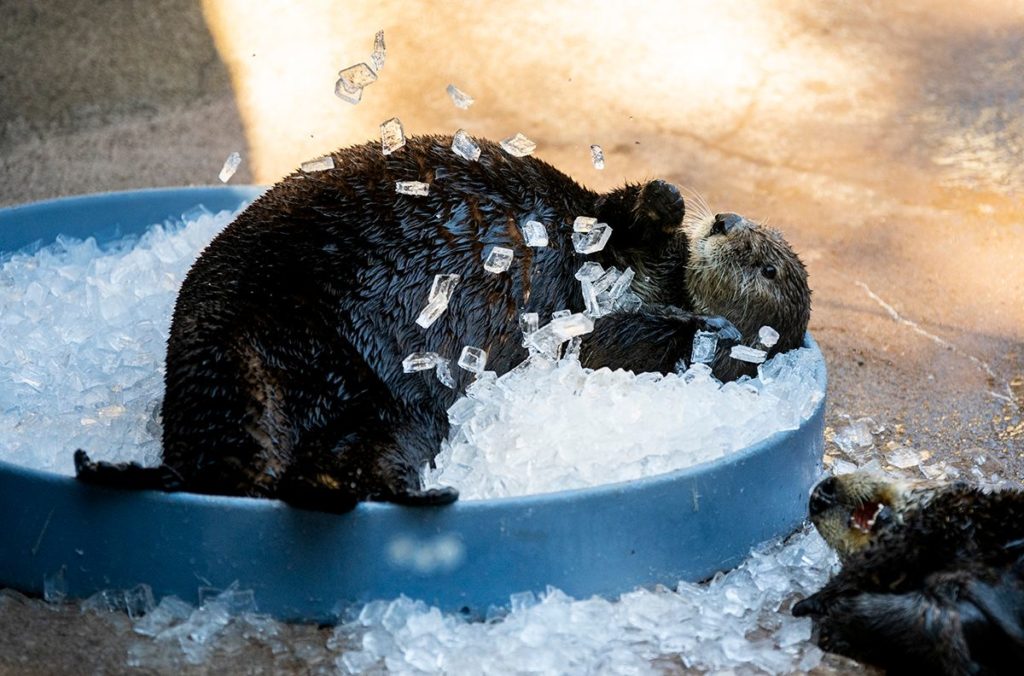Point Defiance Zoo & Aquarium is home to three sea otters in the Rocky Shores habitat. Every September, one week is dedicated to bringing awareness to sea otters. Sea otters are endangered, having been hunted nearly to extinction for their thick fur. Now protected, they are still at great risk from oil spill, parasites that reach the ocean via storm drains, and plastic ocean trash. Of the sea otters living at Point Defiance Zoo, two were rescued and all three are deemed non-releasable to the wild.
Moea
(Pronounced Mia)
Staff at Monterey Bay Aquarium in California rescued Southern sea otter Moea as a stranded otter tainted with oil from a spill. Sea otters rely on their thick fur to keep them insulated and warm, grooming it often to keep it waterproof. When it gets coated with something they can’t clean off themselves – like oil – they can lose the warmth they need to stay alive in cold North Pacific waters.
After rehabilitating Moea, Monterey Bay Aquarium staff returned her to the wild. But the little otter seemed to prefer the company of humans and returned. Because her affinity for people could pose a danger to her in the wild, the Monterey Bay Aquarium found her a home at Point Defiance in 2018. Moea will remain in human care for the rest of her life.
Moea is estimated to be 11 to 13-years-old and keepers describe her as “the sweetest otter.”
“Moea is calm and confident, and really loves her food,” said Assistant Curator Sheriden.
Moea is also the most independent of the three sea otters. If you see an otter by herself in the pool, it’s probably Moea.

Even her name is food-related – a contraction of the scientific name for “sweet potato.”
How to spot her: Moea has a pink scar on her nose. Many female sea otters have a similar scar from mating in the wild. You can also spot Moea swimming around with a toy on her stomach or sleeping as much as she can.
Libby
Libby is also a Southern sea otter, rescued from the wild by the Monterey Bay Aquarium. She was found abandoned at just 24 hours old. Many times, a mother sea otter will abandon a pup if she gives birth to twins (generally, they just have one and can’t care for two) or if they suspect their pup is sick. There is no way to know for certain why Libby was left. Staff at Monterey Bay Aquarium quickly jumped in to help, hand-raising Libby to full health before transferring her to Point Defiance Zoo when she was just 6-months-old. She is now 10-years-old.
“Libby is so easy to train, since she has been with us since she was just a pup,” said Sheriden. “She loves her training sessions and sometimes you’ll see her in her exhibit spinning in circles.”

Her animal care team says the training is for fun, but also offers mental stimulation for the sea otters.
How to spot her: Libby has blonde fur on her head and is the smallest of the three otters.
Sekiu
(Pronounced See-Q”)
Sekiu is the last sea otter born at a zoological facility in the United States. She was born in 2012 at Seattle Aquarium, to mother Aniak, who was also born there and father, Adaa, a rescued sea otter. Because of the amount of abandoned pups in the wild in need of homes every year, zoos agreed to stop breeding sea otters at facilities.
“Sekiu enjoys her training sessions and learning, eating and playing with the other otters,” said Sheriden. “She has a lot of energy and is very athletic and is often seen jumping on the big ball in their pool and trying to hang on.”

How to spot her: Sekiu is a Northern sea otter and is bigger than Libby and Moea who are Southern sea otters. Sekiu weighs around 60 pounds and the two others weigh 40-50 pounds.
Did you know?
Sea otters eat sea urchins, crabs, octopuses, abalone, mussels, clams and snails. They break open clams and other prey using rocks or other hard objects balanced on their chests. Some keep their favorite cracking tool tucked under their arms. Rolling in the water keeps their “table” clean.
Preferring coastal waters, sea otters can be found from Alaska to California.
They are vital for the health of coastal ecosystems, particularly kelp forests like those of Puget Sound and Monterey Bay, as they love to eat the purple sea urchins that would otherwise devour these forests completely.
Sea otters are very social creatures, living in groups of up to 100 in the wild. The otters at Point Defiance Zoo & Aquarium are no exception: Libby, Sekiu and Moea love to play, swim and cuddle with each other.